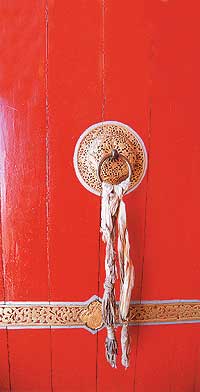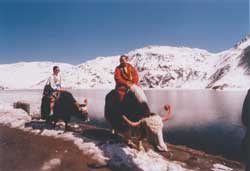 1903, a time for intrigue and explorers. Francis Younghusband, in his obsessive quest for Tibet, makes the journey from Darjeeling into Sikkim, dressed in Marching Orders: "breeches, gaiters, brown boots, flannel shirt, khaki coat and forage cap".
1903, a time for intrigue and explorers. Francis Younghusband, in his obsessive quest for Tibet, makes the journey from Darjeeling into Sikkim, dressed in Marching Orders: "breeches, gaiters, brown boots, flannel shirt, khaki coat and forage cap". Just to get to Rangpo, now a bustling little border town between West Bengal and Sikkim that does a thriving trade in cheap petrol and cheaper booze, he must cross the Teesta by a none-too-reassuring suspension bride and make his way through the dense forests of the Eastern Himalayan foothills, all the while worrying about "a haunting suspicion of fever".
He arrives in Gangtok three days later, crossing a cantilever bridge and cutting through bamboo and elephant creepers, enchanted by the sight of untold varieties of orchids. Further charm awaits him in the Sikkimese capital in the form of the Chogyal's brilliant and beautiful second wife, Yeshe Dolma, "an uncommonly slim little thing". Younghusband, who was, after all a bit of a lunatic about Tibet, steeled his heart against her alluring ways and moved up towards Nathu La, one of the two main passes to Tibet, now more notable for its connection with the 1967 war between China and India, than as a 4,392 m high hiccup on the old Lhasa-Kalimpong trade route.
Younghusband could make that journey in four hours by car today. Come 2005, he could even land in Pakyong, 35 km south-east of Gangtok, on board a regular flight. The overwhelming army presence in Sikkim, particularly as you go up north towards the popular tourist site of Yumthang, is a little disconcerting (though no more than in our own capital), and there are plenty of restricted areas that require more paperwork in triplicate than you'd imagine, but an airport here will almost inevitably result in a real boom in tourism. Bhutan is expensive, and as for Nepal, well, last month in Gangtok we met more than one foreign tourist who'd cancelled a planned trip here in light of their embassy's travel warning, and gone instead to Sikkim.
For the wealthy-or desperate-a four-seater chopper already flies once a day between Gangtok and Bagdogra, an airport with connections to Calcutta and Delhi. Bagdogra will mean a many-fold increase in Sikkim's tourist arrivals, which currently stand at 30-50,000 foreign and 300,000 domestic tourists annually, and rising by something like 20 percent every year. There is only one direct, open surface route between Sikkim and the rest of the world in the rather ugly form of Siliguri-the National Highway 31A, a splendid effort by the ubiquitous Border Roads Organisation.
 The roads built by the BRO are superb all the way up to Nathu La, but the real charm of the route lies in the organisation's adventurous forays into the English language. There are slogans plastered every couple of metres along the highway. (Eg: "Better late than late")
The roads built by the BRO are superb all the way up to Nathu La, but the real charm of the route lies in the organisation's adventurous forays into the English language. There are slogans plastered every couple of metres along the highway. (Eg: "Better late than late") The airport is little more than a clearing just over some 100 m sq right now, and standing on the outskirts of Pakyong, a pleasant-looking large, green village, it doesn't seem possible that an airplane could ever land here. The runway will be 1,600 m long and can accommodate a 50-seater ATR 72. The airport, which is to handle as many as 100 passengers at a time, will allow goods and passengers to travel faster, in higher volume, and more reliably.
But talk to young Sikkimese, especially in Gangtok, and you realise that for them the airport is about more than making moolah-it's about finally, over 25 years after being incorporated into the Indian Union, being a real part of the country. Enough, they say, of being some exotic outpost, even if Sikkim is known for producing an international-standard footballer, Bhaichung Bhutia, and possibly the most urbane villain ever in Bollywood, the brewer of Dansberg beer, Danny Denzongpa, even if the state's own tourism board doesn't hesitate in still calling it a kingdom (as in flower kingdom).
This, after all, is a state that has in two successive elections voted to power Pawan Chamling, a man with a couple of pet peeves. Cut through all the mandatory noises about defence and foreign hands, and ignore for a moment his real passion for what he calls "radical humanism". (See also "India is integrating with Sikkim, and not the other way around," #89.) You hear him loud and clear. First, he points to that falsetto line in the Indian national anthem that goes "Punjab, Sindh, Gujarat, Maratha," and says with the wild-eyed conviction of a man who knows he is tilting at windmills: "It is a matter of great offence that Sindh, which is an inalienable part of another country, is mentioned in our national anthem." He believes it should be replaced with Sikkim. He has another, more modest suggestion. At least alter the Indian rallying cry of "Kashmir to Kanyakumari" to "Kashmir to Kanyakumari to Kangchenjunga."
When in Sikkim, be sure to:
 . Drive up to the stunning, mirror-like Tsomgo Lake at 3,780 m and three hours from Gangtok, get yourself photographed in Tibetan dress atop a yak sporting a carpet that says, to make certain you are absolutely sure: "Welcome to Tsomgo". Marvel at the fact that electricity is taken for granted even at this height, and that a light switch can turn on more than just one 10 W bulb.u Drive further up to a curious little shrine a little lower than Nathu La, dedicated to one Harbhajan Singh, in life army man, in death baba. Ignore the rabble and imagine not Younghusband in 1903, but thousands of Tibetans arriving everyday across one of the passes visible from this road in 1959. Some Tibetans who live in Sikkim say the route is still used by people fleeing the Tibetan Autonomous Region.
. Drive up to the stunning, mirror-like Tsomgo Lake at 3,780 m and three hours from Gangtok, get yourself photographed in Tibetan dress atop a yak sporting a carpet that says, to make certain you are absolutely sure: "Welcome to Tsomgo". Marvel at the fact that electricity is taken for granted even at this height, and that a light switch can turn on more than just one 10 W bulb.u Drive further up to a curious little shrine a little lower than Nathu La, dedicated to one Harbhajan Singh, in life army man, in death baba. Ignore the rabble and imagine not Younghusband in 1903, but thousands of Tibetans arriving everyday across one of the passes visible from this road in 1959. Some Tibetans who live in Sikkim say the route is still used by people fleeing the Tibetan Autonomous Region. . If you really, really want to, get permission in Gangtok and drive up five hours to the border at Nathu La. But if it has rained in recent days lower down, be sure to hire a vehicle with snow-chains, or the persnickety Sikh army men will tell you, with a crinkle of their sunburnt faces and a twirl of their moustachios, that they can't allow you up for fear you'll be stuck there and they'll have to carry out yet another rescue. Once on the pass, possibly the most amusement is derived from the sight of dazed-looking Indian tourists, mostly Bengali, who can't believe they are at the border with China. And that they have just shaken hands with a member of the People's Liberation Army. Too thrilling for words.
. Notice that on this drive, as on any going north in Sikkim, as the vegetation changes from subtropical bamboo to alpine rhododendron and then grasslands, so too do the composition of the scattered buildings and the population. Huts with the regulation filthy snot-nosed children playing outside give way to brilliantly-painted, aluminium-roofed army barracks with the boys in green industriously parading, fixing the water pipes that clog up every night, playing volleyball or, if you are a woman, dropping everything to ogle you with undisguised longing.
. Alternatively, you can drive half-an-hour from Gangtok to any number of wonderful vantage points such as Ganesh Tok in the morning for breathtaking views of Kangchenjunga. A 13-day Kangchenjunga trek would be well worth your while, shorter than on the Nepali side and by all accounts, Maobadi-free. So would a slightly longer trek along the Singalila ridge that separates Sikkim from Nepal. The latter takes you through rhododendron forests and past waterfalls and mountain lakes, and offers view of everything from Everest to Chomolhari, ending right across from Kangchenjunga.
. A trip to Yumthang, at 3,782 m in northern Sikkim, requires dedication and patience, but any travel agent in Gangtok can arrange a trip to this place of green, flower-carpeted meadows with yaks everywhere and snow peaks strutting their stuff. En route to Yumthang is Kabi Longsok, where Sikkimese history began in the 13th century when the Lepcha and Tibetan chiefs signed a treaty of brotherhood.
. Imagining the intrigues at the Rumtek Monastery is another worthwhile exercise, especially when every third person gives you a different number of competing Karmapas and feeds you stories of thousand-car-long processions in favour of the Sherpa Karmapa. Or something like that-there are far too many stories. For other, more spiritual experiences, there are any number of monasteries, some very old and venerable indeed- Phodong Monastery is supposed to have been blessed by the Guru Rinpoche and Tashiding was built back in 1717. Pemagyantse is devoted to the Nyingmapa order of Tibetan Buddhism, the "red hat" sect founded by Padmasambhava.
. Drink Temi tea. Kilo for kilo, the highest grade of Sikkimese tea is more expensive than Darjeeling. It is grown at a higher altitude and on a much smaller tea estate that only cultivates the Finest Tippy Golden Flowery Orange Pekoe.


